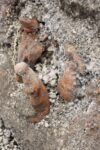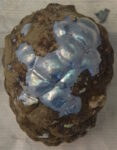The excavation of a domus neighboring the House of Leda and the Swan has uncovered 13 terracotta figurines believed to be associated with the cult of Cybele.
The domus is being excavated to secure the excavation fronts (the boundary areas between unexcavated and excavated sites). On December 11th, archaeologists removing a thick blanket of lapilli (the small pumice stones that pelted Pompeii in the first stage of the eruption of Vesuvius in 79 A.D.) from a room in the domus uncovered a niche in the north-south wall. Inside the niche were 13 terracotta figurines between 15 and 20 cm high (6-8 inches) cast with bivalve molds (clay forms with the negatives of the front and back of the statuettes). They were painted in bright polychrome colors, traces of which survive.
The sculptures emerged from the pumice at a height of over 2 metres above the floor level. The walls of room that contained them, probably the atrium of the house, were painted and frescoes have emerged on the upper part of the walls.

The niche was lined with travertine blocks and the figurines were found upright in a horizontal line, suggesting they were lined up a shelf that was destroyed in the eruption. Many fragments of terracotta were also found, so there were probably many more statuettes on the shelf than the ones that remain largely intact. Most of them are anthropomorphic figures. Non-people represented include a walnut, an almond, the head of a rooster and a glass pine cone that somehow managed not to get smashed to smithereens.

The grouping of figures seem to refer to the myth of Cybele and Attis or to represent symbols used in the cult worship. Originating in Phrygia, the cult of Cybele worshipped her as the goddess of nature and its cycles (birth, death, renewal). According to the myth, Zeus spilled his seed on a stone while attempting to rape Cybele. The androgenous Agdistis was born from that seed. The gods castrated him and from that blood an almond was born. Nana, daughter of the river Sangarius, fell in love with the almond, got pregnant and gave birth to the handsome shepherd Attis. Cybele fell in love with her odd grandchild and forbade his marriage, so he castrated himself under a pine tree. He was then reborn and became Cybele’s consort. This cycle was key to the mystery cult, and Cybele’s priests, known as Galli (also the word for rooster) were eunuchs, said to have castrated themselves at the moment of greatest 𝑠e𝑥ual pleasure as an offering to the goddess. The Galli had another ritual in which they used to beat their chests with pinecones.
One of the figurines is Attis, recognized by his Phrygian cap, the cist he carries, his shepherd’s crook and a rooster. There’s also a separate rooster votive figurine, the almond and pinecone and a fragmentary female figure depicting a mother about to give the breast to her infant.





